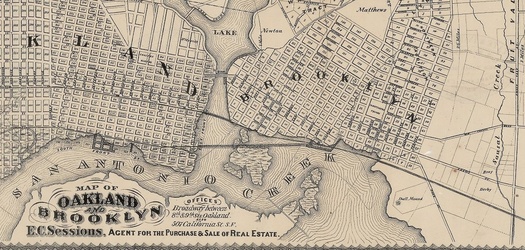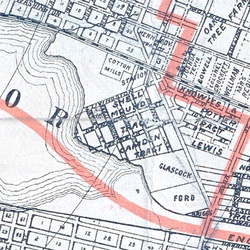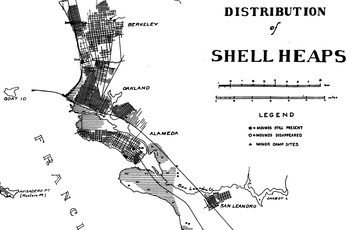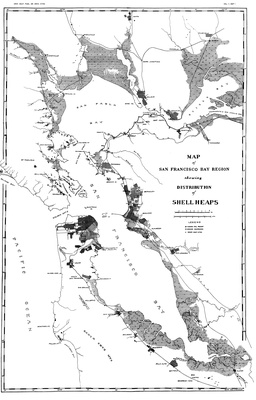[ This is just a start of an entry, but if you have more information about shellmounds in Oakland, please add it here. ]
You may have heard of Shellmound Street in Emeryville, but you may not know about shellmounds in Oakland and the one that gave Shellmound Street its name. They were created by the Ohlone, beginning thousands of years ago and built up over generations. Around the Bay, there were more than 425 shellmounds.
Along with shells of various types, archaeologists excavated more than 700 indigenous graves from Emeryville Shellmound in 1924 when the site was leveled for industrial use. 1
The size and mix of items that comprise the mounds varies from mound to mound, but a 1909 study found one thing they have in common is proximity to a water source. The 1909 study found that over 50% of the contents by weight are shells. 2 with mussel and oyster shells the most common. 3 The Emeryville Shellmound also has clam shells and cockleshells. 4
Jingletown Shellmound
A shellmound was mapped near the site of present-day Dennison Street in 1869. It was the former farm of Capt. E. L. Rodgers in the 1850s and became famous around the state as the Shell Mound Nursery. The area was later subdivided as the Shell Mound Tract, and a Shellmound Street existed there into the 1910s. The site, at Livingston and Embarcadero, is a city-owned lot occupied by a construction company today. See map excerpts.
 Site of the Jingletown shellmound, 1869
Site of the Jingletown shellmound, 1869 shellmound tract shown on the 1889 Vandercook map
shellmound tract shown on the 1889 Vandercook map
Links and References
- There Were Once More Than 425 Shellmounds in the Bay Area KQED Arts November 12, 2018
- The Oakland Shellmound Oakland Geology blog February 6, 2023
- shellmounds The Fastest Slow Guy You Know blog
- Shellmounds of the Bay Area sacredland.org
- Shellmounds of the San Francisco Bay Region by N.C. Nelson, University Press, December 1909 [ NB: language warning ]
- Composition of California Shellmounds by Edward Winslow Gifford, University Press, February 1916
- Emeryville Shellmound on Wikipedia





